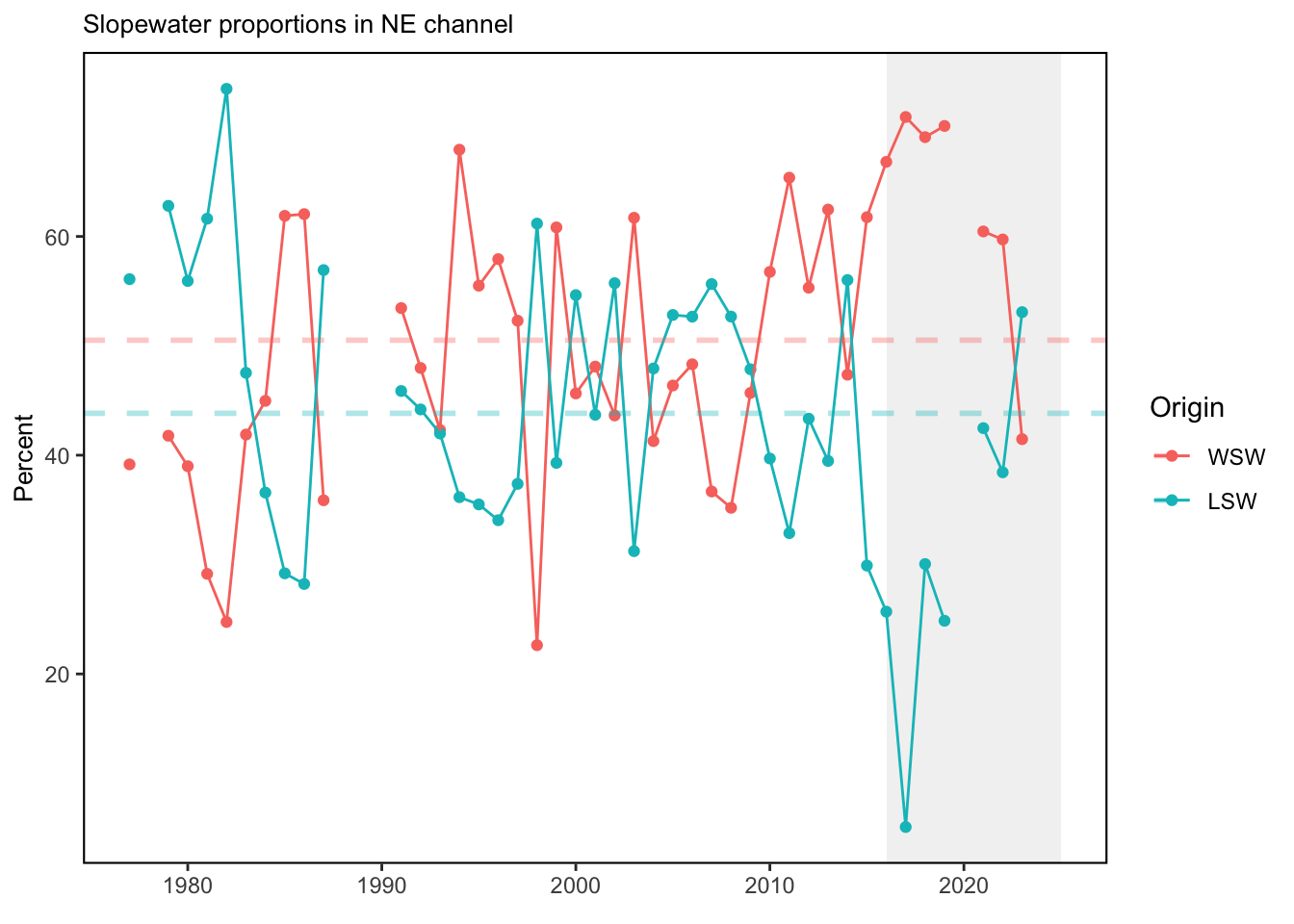SMART Indicator Report: Slopewater Proportions
2 Indicator name
Slopewater Proportions
Includes variable(s): LSLW proportion ne channel, WSW proportion ne channel
3 Indicator brief description
This index gives the relative proportions of watermass type observed in the deep Northeast Channel (150-200 m water depth).
5 Indicator documentation
5.1 Are indicators available for others to use (data downloadable)?
## Yes5.1.1 Where can indicators be found?
## Data: https://noaa-edab.github.io/ecodata/index.html
## Description: https://noaa-edab.github.io/catalog/slopewater.html
## Technical documentation: https://noaa-edab.github.io/tech-doc/slopewater.html5.1.2 How often are they updated? Are future updates likely?
[need sequential look at datasets for update frequency. Future requires judgement]
5.1.3 Who is the contact?
Paula Fratantoni (paula.fratantoni@noaa.gov)
5.2 Gather indicator statistics
5.2.2 Length of time series, start and end date, periodicity
General overview: Annual
Indicator specifics:
Indicator | EPU | StartYear | EndYear | NumYears | MissingYears |
|---|---|---|---|---|---|
LSLW proportion ne channel | GOM | 1964 | 2023 | 52 | 8 |
WSW proportion ne channel | GOM | 1964 | 2023 | 52 | 8 |
5.2.3 Spatial location, scale and extent
General overview: Within the central Northeast Channel
Indicator specifics:
Indicator | EPU |
|---|---|
LSLW proportion ne channel | GOM |
WSW proportion ne channel | GOM |
5.3 Are methods clearly documented to obtain source data and calculate indicators?
## Yes5.3.1 Can the indicator be calculated from current documentation?
[Build link to Tech-doc, look for current and previous methods]
5.4 Are indicator underlying source data linked or easy to find?
[Build link to Tech-doc, look for source, may require judgements]
5.4.1 Where are source data stored?
[Build link to Tech-doc, look for source, may require judgement]
6 Indicator analysis/testing or history of use
6.1 What decision or advice processes are the indicators currently used in?
Temperature and salinity measurements are examined to assess the composition of the waters entering the Gulf of Maine through the deep Northeast Channel. The analysis closely follows the methodology described by [90]. This method assumes that the waters flowing into the Northeast Channel between 150 and 200 meters depth are composed of slope waters, originating offshore of the continental shelf, and shelf waters, originating on the continental shelf south of Nova Scotia.
6.3 Do target, limit, or threshold values already exist for the indicator?
[Fill by hand; if not in key results or implications, likely does not exist]
6.4 Have the indicators been tested to ensure they respond proportionally to a change in the underlying process?
[Fill by hand; if not in introduction, key results, or implications, likely not tested]

7 Comments
[Fill below by hand once above data complete]
7.1 Additional potential links to management in addition to uses listed above
7.2 What additional work would be needed for the Council to use the indicator?
7.3 What issues are caused if there is a gap or delay in data underlying the indicator